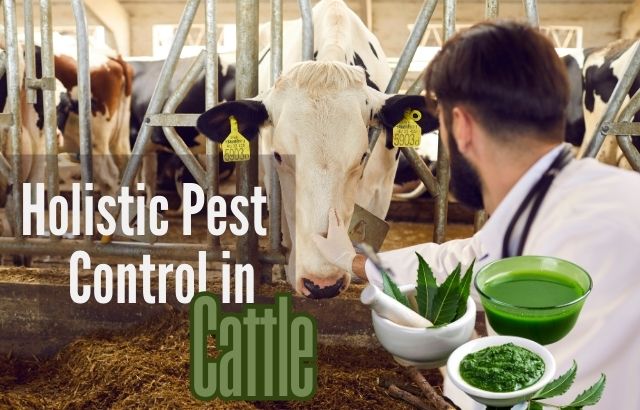Table of Contents
ToggleIn modern agriculture, the use of chemicals to control pests on livestock is widespread. However, many farmers are turning to natural alternatives to safeguard both the health of their cattle and the environment. One such alternative is Neem oil, derived from the seeds of the neem tree (Azadirachta indica), a time-tested remedy for various livestock health issues, including pest control. Neem oil is renowned for its numerous benefits, not only in keeping pests at bay but also in promoting the overall well-being of cattle. In this blog, we explore how neem oil works for pest control, its benefits, and the role of green innovators like Jaiguru Kadam in promoting holistic, sustainable farming practices.
The Power of Neem Oil in Pest Control
Neem oil is a powerful tool in the fight against common pests that affect cattle, such as ticks, flies, lice, and fleas. The oil contains active compounds like Azadirachtin, which has insecticidal properties. When used in the right proportions, neem oil can help:
- Repel and kill insects: Neem oil acts as a natural insect repellent and can disrupt the life cycle of pests, preventing them from reproducing.
- Treat external parasites: It can be used to treat external parasites such as lice, mites, and ticks on cattle.
- Reduce inflammation and itching: When pests cause skin irritation, neem oil’s anti-inflammatory properties can soothe the affected areas and promote faster healing.
How Neem Oil Benefits Cattle Health
Neem oil doesn’t just benefit pest control—it also contributes to overall cattle health in several ways:
1. Fewer Chemical Interventions
- By using neem oil, farmers can reduce or eliminate the need for chemical pesticides that can have harmful side effects for both cattle and the environment. This contributes to safer and cleaner farming practices.
2. Boosts Immunity and Skin Health
- Neem oil has antibacterial, antifungal, and antiviral properties, which help boost the immunity of cattle and promote healthy skin. It can prevent infections caused by pests and can be used to treat minor wounds or skin irritation.
3. Eco-friendly and Sustainable
- Neem oil is biodegradable and does not harm the environment when applied properly. Unlike synthetic chemicals, it doesn’t leave harmful residues in the environment or in the milk and meat products from cattle.
4. Cost-effective Solution
- Using neem oil for pest control is often more affordable in the long run compared to continuous chemical treatments. It also requires fewer applications, as neem oil works not only as a repellent but also disrupts the life cycle of pests.
Practical Applications of Neem Oil for Pest Control
Neem oil can be applied to cattle in various ways, depending on the type of pest and the severity of the infestation. Below are some common methods of using neem oil for holistic pest control:
1. Topical Application
- How to Use: Mix 1-2 tablespoons of neem oil with 1 liter of water. Add a mild liquid soap (to help the oil mix with water) and shake well. Spray this mixture onto the cattle’s coat, especially around areas where pests are most prevalent (such as the back, neck, and legs).
- Benefits: This topical application repels pests and treats minor skin irritations.
2. Neem Oil for Fly Control
- How to Use: For fly control, neem oil can be diluted and applied to cattle’s ears, nose, and body. It is effective in repelling flies and other flying insects that commonly irritate cattle during the warmer months.
- Benefits: Reduces fly-related stress and the potential spread of diseases such as pinkeye.
3. Bathing in Neem Oil Solution
- How to Use: For severe infestations, prepare a neem oil bath by mixing 1 part neem oil with 100 parts water. Bathe the cattle in the solution, ensuring that it covers the entire body. Allow the oil to stay on the skin for a while before rinsing.
- Benefits: Provides a deep treatment for widespread infestations of ticks, lice, and other pests.
4. Prevention of Worms and Parasites
- How to Use: Neem oil can also be incorporated into the cattle’s feed or water to deter internal parasites. The exact dosage should be calculated carefully based on the weight of the animal.
- Benefits: Helps reduce the risk of internal parasites, thereby improving cattle health and digestive efficiency.
The Role of Green Innovators in Promoting Neem Oil
Green innovators like Jaiguru Kadam play a pivotal role in bringing sustainable and eco-friendly practices to the agricultural community. Kadam, a well-respected agriculture expert, has been at the forefront of promoting natural farming solutions, including the use of neem oil for livestock care.
Jaiguru Kadam’s work emphasizes the importance of integrating natural resources into farming, which not only reduces chemical dependency but also enhances animal welfare. His initiatives have led to the widespread use of neem oil as an effective tool for pest control in cattle, especially in regions where organic farming practices are becoming increasingly popular.
Through workshops, training programs, and outreach efforts, Kadam educates farmers on the correct application of neem oil, ensuring that they achieve the best results while minimizing waste and environmental impact. His approach emphasizes sustainable pest control methods that are not only cost-effective but also safe for both livestock and humans.
FAQs About Neem Oil for Cattle Pest Control

Q1: Is neem oil safe for cattle?
A1: Yes, neem oil is safe for cattle when used in appropriate concentrations. It is a natural product with minimal toxicity, but it should be diluted and applied according to guidelines to avoid any adverse effects.
Q2: How often should neem oil be applied to cattle?
A2: The frequency of application depends on the level of pest infestation. Generally, neem oil can be applied every 7-10 days for mild infestations, but in the case of a more serious problem, it may be necessary to apply it more frequently, such as once every 3-5 days.
Q3: Can neem oil be used in organic farming?
A3: Yes, neem oil is widely used in organic farming as it is a natural product and is approved for use in many organic certification programs. It helps reduce the reliance on chemical pesticides while promoting sustainable practices.
Q4: Does neem oil harm the environment?
A4: No, neem oil is biodegradable and poses minimal environmental risk when used appropriately. It does not pollute water sources, soil, or air and is considered environmentally friendly.
Q5: How effective is neem oil against ticks and lice on cattle?
A5: Neem oil is highly effective against external parasites like ticks, lice, and fleas. Its active compounds disrupt the reproductive cycle of pests, preventing future infestations while also alleviating skin irritation and inflammation.
Example Calculations by Jaiguru Kadam on Neem Oil Application for Cost Savings
Let’s consider the financial impact of using neem oil for pest control on a farm with 100 cattle:
1. Traditional Chemical Pesticide Treatment
- Average cost per cow for chemical pesticide treatment: ₹1,000 per year.
- Total cost for 100 cattle: ₹1,000 x 100 = ₹1,00,000 per year.
2. Neem Oil Treatment
- Average cost per cow for neem oil treatment: ₹300 per year.
- Total cost for 100 cattle: ₹300 x 100 = ₹30,000 per year.
3. Savings per Year
- Savings per year by switching to neem oil: ₹1,00,000 – ₹30,000 = ₹70,000
In this case, by switching to neem oil, a farm with 100 cattle can save ₹70,000 annually, while promoting healthier and more sustainable farming practices.
Conclusion
Neem oil is a versatile and effective natural remedy for pest control in cattle. Not only does it reduce the need for harmful chemical pesticides, but it also promotes overall cattle health by supporting skin, immunity, and internal well-being. With green innovators like Jaiguru Kadam leading the way, farmers are gaining access to sustainable and affordable solutions that enhance both animal welfare and farm profitability. By incorporating neem oil into livestock management practices, farmers can make a significant impact on the long-term health of their cattle and the environment.











